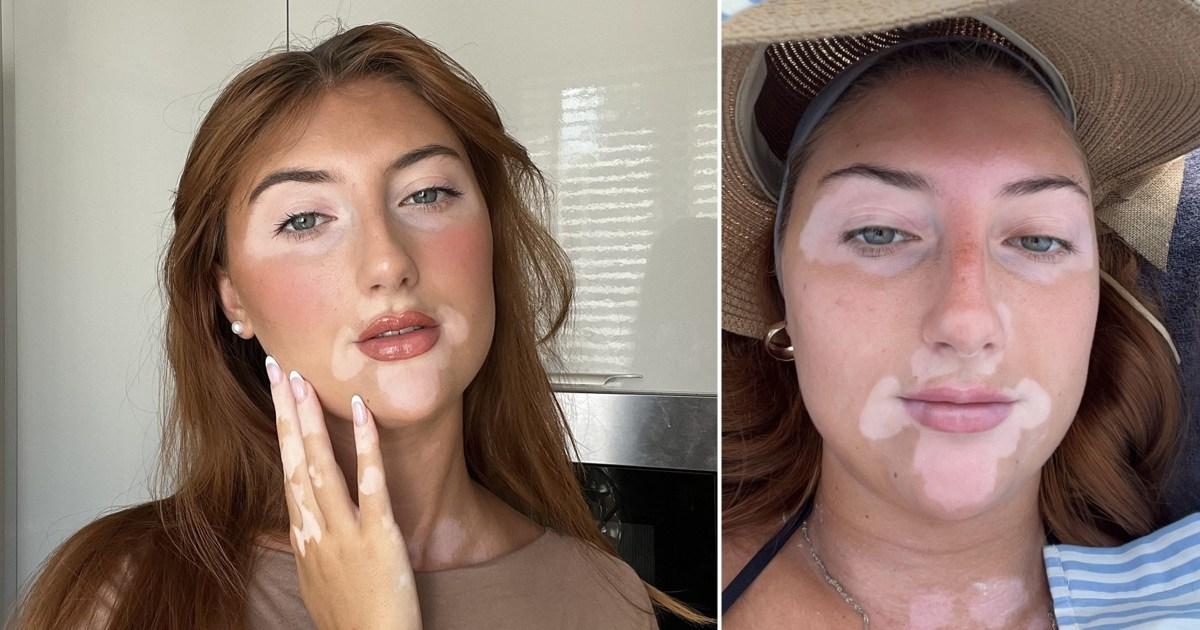
‘Sometimes it can feel like being an animal at the zoo,’ said Eva Smith, 20, of the way she gets stared at, day in, day out.
Eva has vitiligo, an autoimmune disease that causes patches of skin to lose pigment and often turn a milky-white colour.
She says she’s often asked if she’s had a dodgy fake tan due to a lack of understanding about her condition.
Eva, an entrepreneur from North West London, said: ‘Fake tan comments are probably the most common one.
‘People assume that I have done my fake tan really badly or think I haven’t washed off the fake tan properly.
‘The comments don’t make me feel bad about myself but it makes me feel awkward.
To view this video please enable JavaScript, and consider upgrading to a webbrowser thatsupports HTML5video
‘When people say things like this I just explain to them that I have an autoimmune disease and I can’t help it.’
Eva’s condition developed when she was three-years-old with patches appearing on her knees and neck.
After receiving UV radiotherapy twice a week hospital for a year, the vitiligo completely vanished by the age of seven, but it returned four years later, possibly from stress.
Eva feels she had her radiotherapy because her parents were ‘self-conscious for [her] and being protective’, but she doesn’t want other children to feel the same.
‘I worry now that if kids have treatment at a young age and try to get rid of it, it will make them think that they shouldn’t have it [vitiligo],’ said Eva.

‘Getting rid of it so young doesn’t give you a chance to be comfortable with it and promotes that it is wrong and not normal – at the end of the day it is just your skin.’
Whilst further UV radiotherapy is available to Eva, she said she would not have this treatment done again as it also increases her risk of skin cancer.
Now, her face, neck and hands are covered in milky-white clusters but, she says she embraces her spots and often goes make-up free despite the stares and comments she receives.
She says she gets the most comments when she’s abroad due to a lack of awareness – people even point her out to their friends and family.
‘It can sometimes feel very uncomfortable when you know all eyes are on you and you have to carry on as normal,’ she added.
‘I’ve had kids ask me if I have paint on my hands or whether I can wash it [the vitiligo] off.
The types of vitiligo:
There are 2 main types of vitiligo:
- non-segmental vitiligo
- segmental vitiligo
In rare cases, it’s possible for vitiligo to affect your whole body. This is known as universal vitiligo.
In non-segmental vitiligo (also called bilateral or generalised vitiligo), the symptoms often appear on both sides of your body as symmetrical white patches.
Symmetrical patches can appear on the:
- backs of your hands
- arms
- skin around body openings, such as the eyes
- knees
- elbows
- feet
Non-segmental vitiligo is the most common type of vitiligo, affecting around 9 in 10 people with the condition.
In segmental vitiligo (also known as unilateral or localised vitiligo), the white patches only affect one area of your body.
Segmental vitiligo is less common than non-segmental vitiligo, although it’s more common in children. It usually starts earlier and affects around 3 in 10 children with vitiligo.
Source: NHS
‘I just laugh them off because I genuinely find them funny as I know kids don’t understand.’
Others have asked Eva if her vitiligo is contagious, questioning if ‘they can come close to [her] or not’.

But for Eva, she has a role model in supermodel Winnie Harlow, who has used her platform to raise awareness of her condition.
‘It makes such a big difference having someone like that with the same disorder as you. It makes me feel more comfortable and makes people aware of it,’ she says.
Now, Eva enjoys wearing makeup but often removes foundation from her spots on her face to embrace them in her everyday look.

She said: ‘I love having my patches on show.
‘My big thing is not covering it up.
‘I’m in a place now where I really enjoy having it. I can’t imagine myself without it.’
Eva has now created a TikTok page to raise awareness of her vitiligo and show people, especially younger kids with the same condition, that the disorder is normal and should be accepted.
‘Whilst people speak about vitiligo more than they did when I was younger, we still need to speak more about it,’ she says.
Do you have a story to share?
Get in touch by emailing [email protected].
Source: Read Full Article
